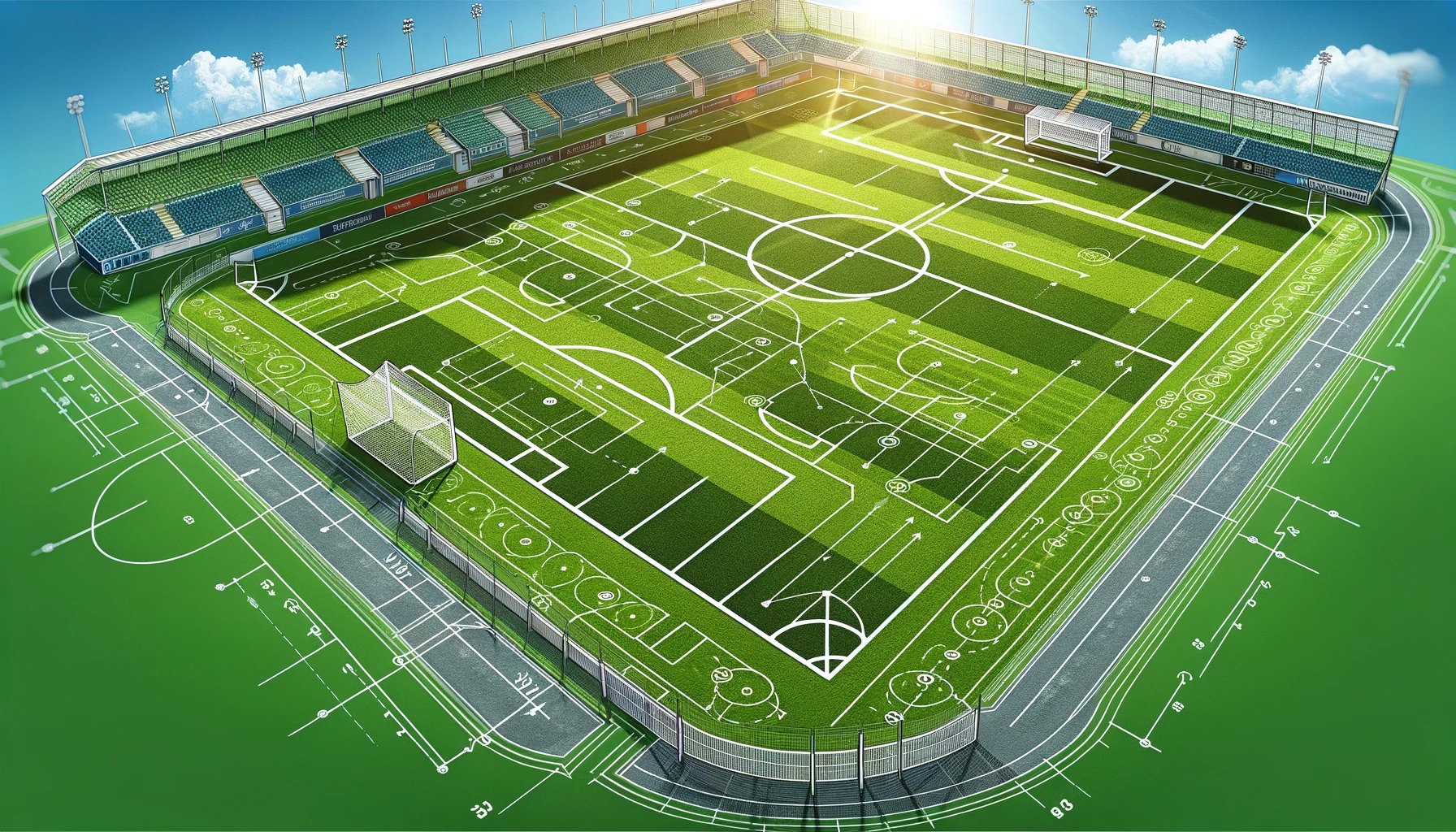During the mid-19th century, Association Football, more commonly known as soccer, was formalized in British colleges and schools. This period saw heated disputes and disagreements over the laws of the game. A crucial point of contention was the size of the standard field of play. It was a time when soccer was transforming, and these debates were essential in shaping the sport as we know it today.
Interestingly, most of us don’t often think about the dimensions of a soccer field, but they are crucial aspects of the game. The pitch-based issues, including the playing surface, whether it be grass or artificial turf, play a significant role. As a soccer enthusiast, I’ve always found that maintaining consistency and fairness across different fields is vital. This uniformity ensures that the game remains fair and competitive, regardless of the location.
From personal experience, understanding the typical length, width, and overall size of a soccer field has enhanced my appreciation for the sport. These measurements are not just numbers; they are a testament to the sport’s evolution and the effort to balance tradition with modern requirements. Whether in professional soccer or local clubs, the field’s dimensions connect players to the game’s rich history.
How Big Is A Soccer Field?
While watching a game, the soccer field often remains an overlooked aspect of the sport. Yet, its dimensions, markings, and surface are incredibly important. The big question is: how big is a typical soccer field? The view from the stands rarely gives justice to the actual length and width of the field.
The International Football Association Board (IFAB), the governing body that writes the rules of soccer, states that a field must be rectangular and marked with continuous lines. A full-size pitch may range anywhere from 50-100 yards in width to 100-130 yards in length. This flexibility in size acknowledges the diverse needs of the sport at different levels.
However, the international governing body, FIFA (Fédération Internationale de Football Association), gets more specific about the regulation soccer field. According to FIFA, a regulation field should be between 110 and 120 yards long, and 70 to 80 yards wide. This specification ensures a standard playing experience at the highest level of the sport.
In terms of optimum size, a soccer field is ideally 360 feet long (120 yards) by 225 feet wide (75 yards). Despite these regulations, soccer pitches can vary in size across the world. For instance, high school soccer fields often have smaller dimensions, with youth soccer sides or amateur teams operating at a lower physical level than pro players. The greatest stadiums globally tend to use fields at the top end of the spectrum.
It’s interesting to note that guidelines for an international soccer field are a bit more strict, ensuring that all international matches are played on similar-sized fields. The laws state that pitches must be 70-80 yards wide, in contrast to the more lenient standard of 50-100 yards in width. This variation in pitch length and width is fundamental to the game’s adaptability and inclusivity.
How Long Is A Soccer Field?
International soccer field regulations specify that a field must be a minimum of 110 yards long and a maximum of 120 yards. However, the more lenient FIFA standard for club soccer allows pitch lengths of between 100-130 yards. This variance in size reflects the sport’s adaptability at different levels, from international arenas to local clubs.
At lower levels of the game, soccer fields might be closer to 50m in length, which is generally considered adequate for youth and amateur play. The dimensions used at the top level of the game are often seen as the ideal to aspire to, but flexibility allows for a diverse range of playing environments.
The length of a soccer field doesn’t just determine its physical space; it significantly impacts the styles of play utilized during a game. For instance, a short pitch can encourage teams to opt for long-balls, going direct to their forward players and bypassing the midfield.
Conversely, a smaller field can lead to a heightened use of attacking set-pieces like throw-ins and corners. On the other hand, an especially large pitch tends to promote possession-based football, characterized by calm, methodical passing. This diversity in field size allows for a broad spectrum of tactical approaches, making soccer a uniquely adaptable and global sport.
How Many Square Feet is a Soccer Field?

When considering the square footage of a soccer field, the average size is about 81,000 square feet. This size, however, is not one-size-fits-all; it varies significantly based on the age and level of the players. For instance, children under the age of 8 typically play on smaller pitches that range from 5,400 to 13,500 square feet. These dimensions are perfectly tailored to their physical capabilities and help in creating a more engaging and manageable game environment for young players.
As the players grow, so does the size of the field. Those who are 9 or 10 years old find themselves running a bit more, as they are playing on soccer fields that are between 13,500 and 21,600 square feet. The increase in field size challenges these young athletes to develop greater endurance and adapt to more strategic plays.
The field size reaches its peak for adult players. Male adults typically play on fields that are between 45,000 and 117,000 square feet. For adult female players, the range is slightly different, usually between 73,710 and 81,000 square feet. These variations reflect not just the physical differences among age groups and genders but also underline the sport’s adaptability to various playing styles and strategies at different levels.
How Many Acres Is A Soccer Field?
Soccer fields can vary significantly in length, width, and overall size. Despite regulations aimed at keeping them within appropriate limits, the average soccer field used for adult play is typically around 81,000 square feet. To put this into perspective, that’s about 1.86 acres. This expanse underscores the fact that soccer is not just a game of skill but also one of endurance and spatial awareness.
This vast area might sound like a lot, and indeed, it is. It helps us realize the immense levels of fitness and stamina required to play soccer at a high standard. It’s not just the players who need this physical capability; game officials like the Referee and Assistant Referees also need the endurance to charge around a regulation soccer field for long periods. The size of the field plays a crucial role in shaping the physical and strategic aspects of the game, making it a demanding yet thrilling sport.
How Many Square Feet is a High School Soccer Field?
In the US, high school soccer is played on fields that, while often under the regulations for adult players, still cover a substantial area. These fields typically span a range from 49,500 to 86,400 square feet. This size accommodates the developmental stage of high school athletes, providing ample space for their growing skills. It’s fascinating to see how these young players adapt to these larger fields, a transition that prepares them for the next level of the game.
As these athletes progress to college, they can expect to be playing on a field with an area of 72,450 to 81,000 square feet, as per NCAA prescribed soccer field sizes. This implies that college soccer fields can range from 1.66 to 1.98 acres, a significant jump in size, reflecting the increased physical and tactical demands at the collegiate level.
Interestingly, both male and female high schoolers in the US typically play on the same fields, a practical approach considering it wouldn’t be feasible for schools across the nation to build multiple soccer fields for different gender categories.
How Many Square Feet is an Indoor Soccer Field?
As per the rules, an indoor soccer field must range in length from 58 to 70 yards and in width from 25 to 33 yards. This dimensional requirement means the total area of an indoor soccer field can vary significantly, spanning anywhere between 13,125 and 21,000 square feet. This size is tailored to suit the unique pace and style of indoor soccer, offering a compact yet dynamic playing experience.
Soccer Field Markings

The pitch and its size are crucial, but the markings on a soccer pitch are equally important. These include the goal lines, the corner arc, and various markings inside the penalty box and goal area. It’s essential for these to be accurate and consistent, as they are vital for the roles of referees, assistant referees, players, and coaches.
The Basics of Field Marking
When you have watched a soccer game, you might have noticed that each field of play is marked with white lines. These are usually applied manually using paint. Every line on the pitch, from the outer lines to the halfway line, the penalty box markings, the center circle, and the corner markings, is carefully measured to ensure precision.
Halves and Center Circle
The perimeter of the soccer field represents the dimensions we’ve discussed earlier. The halfway line effectively divides the field into two halves, running from touchline to touchline (the long side lines). At the heart of the field is the center mark, about nine inches in diameter, encircled by the center circle with a radius of 10 yards.
The Penalty Area
Moving to the penalty areas, the 18 yard box is a key feature. This rectangular zone extends 18 yards from the goal line and 18 yards to either side of the goal posts. The penalty spot, or penalty mark, placed 12 yards out from the center of the goal, becomes the focal point during a penalty kick or shootout. Here, all players must remain 10 yards away from the ball, except the penalty taker.
The D and its Significance
Another vital marking is “the D”. This arc at the top of the penalty area is where players must stand behind during a penalty kick. Its strategic placement and unique shape play a critical role in the game’s dynamics during these high-tension moments.
Goal Area
Finally, we have the 6 yard box, essential for both defenders and attackers. Positioned six yards from the goal line and extending six yards from the outside of each post, it marks a crucial area for goalkeepers during goal-kicks. This space is often where crucial plays unfold near the goal mouth.
Goal Dimensions
And a note on the goals themselves: soccer goals are regulated to be eight yards wide, measured between the inside of both posts. The crossbar should be eight yards above the ground, measured at the lower edge of the crossbar. Both the posts and the bar must be no wider than five inches to conform to standard regulations.
Conclusion
Understanding the dimensions of a soccer field is crucial for players, coaches, referees, and fans alike. From the expansive FIFA-regulated fields to the more compact pitches used in youth and indoor soccer, the size of a soccer field can greatly influence the style and dynamics of the game. Measured in square feet, yards, or meters, these dimensions not only comply with specific regulations but also cater to the physical demands and tactical intricacies of soccer at various levels.
Whether it’s a professional stadium hosting international matches or a local field where future stars are nurtured, the soccer pitch remains a central and sacred component of this beloved sport.
Frequently Asked Questions
Are all soccer fields the same size?
No, all soccer fields are not the same size. The dimensions can vary based on the level of play. FIFA regulations suggest specific dimensions for professional play, but fields for youth, amateur, and indoor soccer can differ in size.
What is the size of the FIFA soccer field?
A FIFA soccer field is typically between 110 and 120 yards long and 70 to 80 yards wide. This translates to approximately 81,000 square feet in total area.
What is the size of a football field in square feet?
In general, a football (soccer) field measures about 81,000 square feet. However, this can vary depending on the specific regulations governing the match or league.
What is the size of a football pitch in feet?
A standard football (soccer) pitch is usually about 360 feet long and 225 feet wide, totaling around 81,000 square feet. These dimensions are subject to variation based on the governing body’s rules.
How many meters is a soccer field?
A standard soccer field is typically between 100 and 110 meters long and 64 to 75 meters wide, according to FIFA regulations.
What size is a U15 soccer field?
For U15 soccer, the field size can vary, but it generally measures around 100 yards (300 feet) in length and 50 to 100 yards (150 to 300 feet) in width. The specific size can depend on league or regional regulations.

